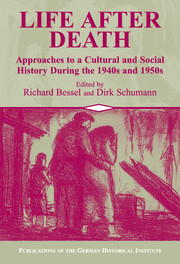Book contents
- Frontmatter
- Introduction Violence, Normality, and the Construction of Postwar Europe
- 1 Post-Traumatic Stress Disorder and World War II
- 2 Between Pain and Silence
- 3 Paths of Normalization after the Persecution of the Jews
- 4 Trauma, Memory, and Motherhood
- 5 Memory and the Narrative of Rape in Budapest and Vienna in 1945
- 6 “Going Home”
- 7 Desperately Seeking Normality
- 8 Family Life and “Normality” in Postwar British Culture
- 9 Continuities and Discontinuities of Consumer Mentality in West Germany in the 1950s
- 10 “Strengthened and Purified Through Ordeal by Fire”
- 11 The Nationalization of Victimhood
- 12 Italy after Fascism
- 13 The Politics of Post-Fascist Aesthetics
- 14 Dissonance, Normality, and the Historical Method
- Index
14 - Dissonance, Normality, and the Historical Method
Why Did Some Germans Think of Tourism after May 8, 1945?
Published online by Cambridge University Press: 05 January 2013
- Frontmatter
- Introduction Violence, Normality, and the Construction of Postwar Europe
- 1 Post-Traumatic Stress Disorder and World War II
- 2 Between Pain and Silence
- 3 Paths of Normalization after the Persecution of the Jews
- 4 Trauma, Memory, and Motherhood
- 5 Memory and the Narrative of Rape in Budapest and Vienna in 1945
- 6 “Going Home”
- 7 Desperately Seeking Normality
- 8 Family Life and “Normality” in Postwar British Culture
- 9 Continuities and Discontinuities of Consumer Mentality in West Germany in the 1950s
- 10 “Strengthened and Purified Through Ordeal by Fire”
- 11 The Nationalization of Victimhood
- 12 Italy after Fascism
- 13 The Politics of Post-Fascist Aesthetics
- 14 Dissonance, Normality, and the Historical Method
- Index
Summary
Every historical period offers its dissonances: that which actually happened but seems totally incongruent with the conditions of the time and which therefore tests to the limit the interpretative ability of the historian. I would like to present such a dissonance: Germans thinking of tourism following Germany's May 1945 defeat, in the midst of rubble, hunger, and occupation. We think about this period in many terms, but tourism is not one of them. And by denoting the period after May 1945 I do not mean the following years leading to the 1950s, but the following days and weeks. Who dared to think of tourism after May 8, 1945? Is the historian fantasizing? Or is history fantastically unpredictable?
On September 1, 1945, in the city of Emden, a group of tourist activists, soon to be organized into the Regional Tourist Union of East Friesland (Landesverkehrsverband Ostfriesland), asked the Allied occupation authorities for permission to resume activities. Was this a case of Germans who, following the years of war, had become mentally imbalanced? The reverse seems true. On July 20, 1945, five weeks before the Emden case and merely six weeks after Germany’s defeat, a meeting took place at Braunschweig’s Ministry of State between a senior government official, Dr. Voigt, and the director of a local spa, Mr. Fick, who also was a high official at the Regional Tourist Union of the Harz (Landesfremdenverkehrsverband Harz). On the agenda was the immediate reconstruction of Lower Saxony’s tourism industry.
- Type
- Chapter
- Information
- Life after DeathApproaches to a Cultural and Social History of Europe During the 1940s and 1950s, pp. 323 - 348Publisher: Cambridge University PressPrint publication year: 2003
- 1
- Cited by



